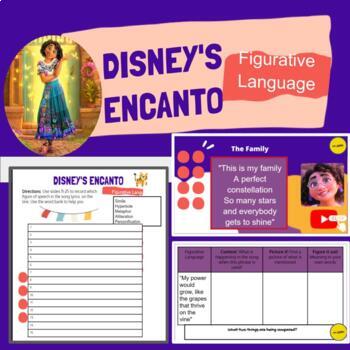Google Slides and Figurative Language Worksheet Disney's Encanto
- Zip
What educators are saying
Description
Are your students obsessed with Encanto? This fun lesson is the perfect integration of Disney with figurative language in the classroom. It can be used as introduction or review of five types of figurative language: simile, metaphor, hyperbole, personification, and alliteration. Each figurative language slide (1-9) introduces a figure of speech with a definition, example, and additional video resource. Slides 10-25 include figurative language lyrics from the Encanto's soundtrack where students can work together on a worksheet to identify the figure of speech from the film. These slides also include a quick link to each Youtube video so students can sing along! Finally, slides 26-31 include graphic organizers for students to go further into analysis by thinking through context, visualization, and finally understanding. Students can do this independently as an extension activity, with distance or COVID learning, or as a whole class.
Other resources you may enjoy:
- STAAR Comprehension | PDF Google Forms & Task Cards | New TEKS Encanto Set 1 (teacherspayteachers.com)
- STAAR Comprehension | PDF Google Forms & Task Cards | New TEKS Encanto Set 2 (teacherspayteachers.com)
- STAAR Comprehension | PDF Google Forms & Task Cards | New TEKS Encanto Set 3 (teacherspayteachers.com)
- STAAR Comprehension | PDF Google Forms & Task Cards | New TEKS Encanto Set 4 (teacherspayteachers.com)
- BUNDLE Disney's Encanto STAAR Comprehension | PDF Google Forms & Task Cards | (teacherspayteachers.com)


